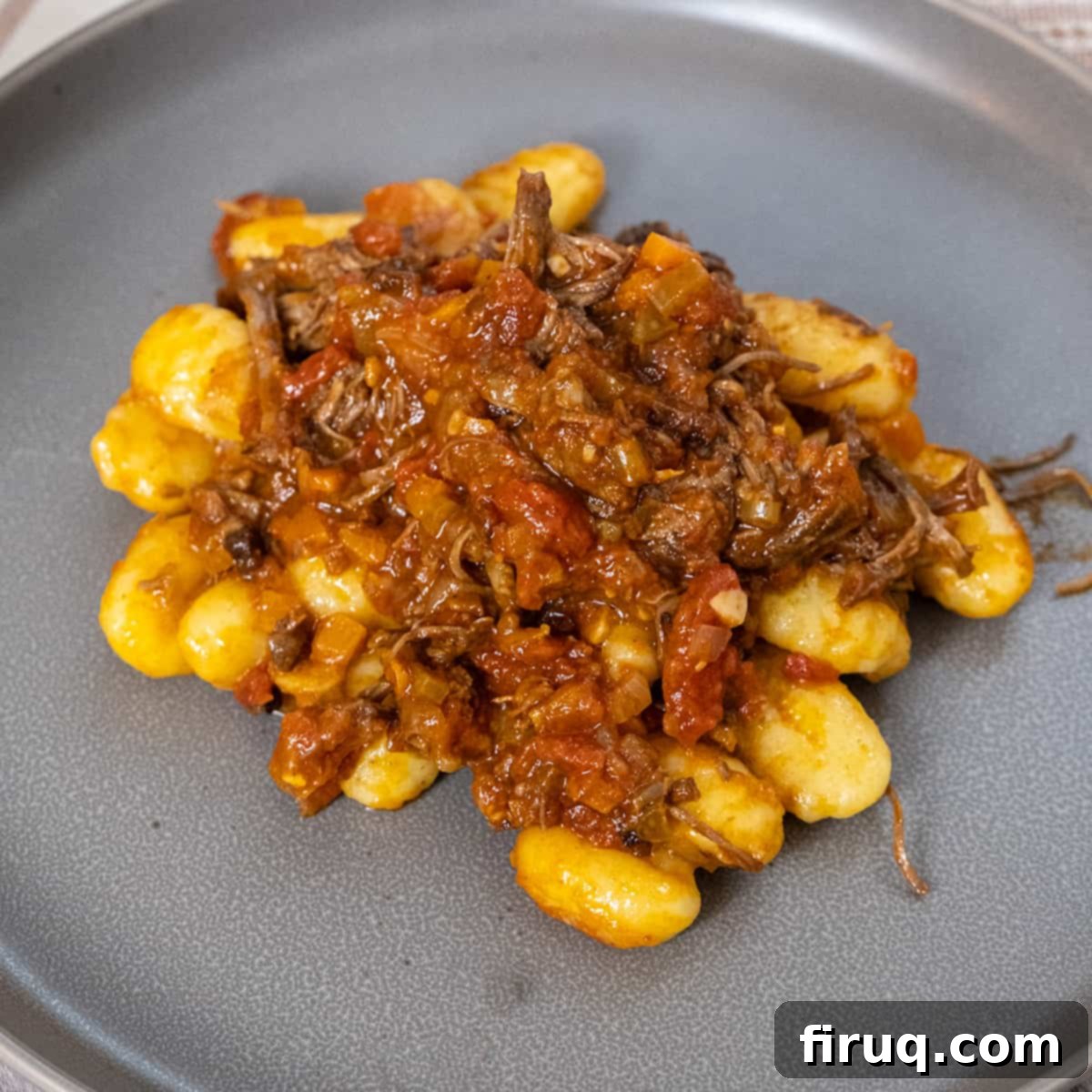Irresistible Italian Short Rib Ragu with Gnocchi: The Ultimate Slow-Cooked Sunday Dinner
There’s a certain magic that fills the kitchen on a Sunday when a rich, savory ragu simmers slowly on the stove or in the oven. This isn’t just any sauce; it’s a labor of love, a culinary masterpiece, and a true testament to the heart of Italian cooking. Our Italian short rib ragu, braised for hours in a trusty Dutch oven, transforms humble short ribs into incredibly tender, fall-off-the-bone perfection. Served generously over fluffy potato gnocchi, it’s a meal designed to gather family and friends around the table for an unforgettable dining experience.
Short ribs are truly the ideal cut for this kind of slow-cooking. Their inherent marbling and connective tissues break down beautifully over a few hours, releasing deep, complex flavors that enrich the tomato-based sauce. The result is a luxurious ragu, brimming with umami, that clings perfectly to every delicate gnocchi. This dish is more than just food; it’s a tradition, a warm embrace, and a comforting centerpiece for any special occasion or a cozy Sunday gathering.
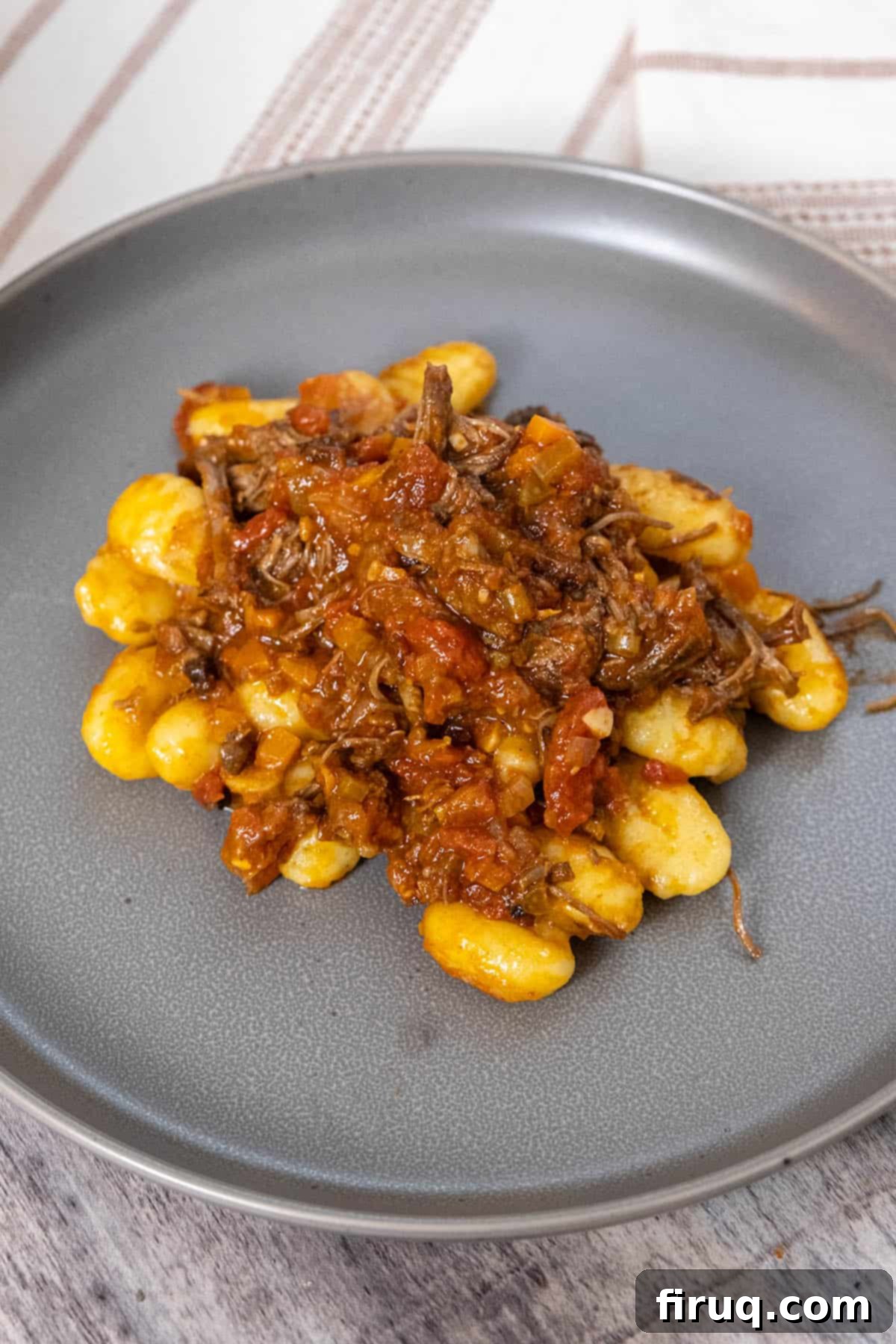
If you adore the tradition of a hearty Sunday sauce, you might also enjoy these other cherished recipes: Authentic Bolognese, Authentic Italian Sunday Sauce, or our comforting Bison Ragu.
[feast_advanced_jump_to]
Essential Ingredients & Expert Substitutions
Crafting a truly exceptional Italian short rib ragu begins with selecting the right ingredients and understanding how each one contributes to the symphony of flavors. Here’s a deeper dive into what you’ll need and how to make the best choices:
Short Ribs. You generally have two options: boneless or bone-in. While I’ve successfully prepared this dish with both, I personally advocate for bone-in short ribs. The bone imparts a profound depth of flavor to the sauce during the long braising process, creating a richer, more authentic taste. Furthermore, I find that bone-in short ribs often become easier to shred once perfectly tender, as the meat naturally separates from the bone. The images featured in this blog post happen to showcase boneless ribs, but rest assured, the fundamental technique remains the same, yielding delicious results either way. Look for well-marbled ribs, as the fat will render down, keeping the meat moist and contributing to the sauce’s richness.
Red Wine. The choice of red wine is absolutely crucial here, as it’s a pivotal flavor component in this robust ragu. Always opt for a dry, full-bodied red like a Merlot or Cabernet Sauvignon. My personal rule of thumb is to always cook with a wine that I would enjoy drinking. I admit, I can be a bit of a wine snob when it comes to cooking – I’ll happily enjoy a light beer all day, but when it comes to my sauces, I prefer a quality bottle over a cheap one. The nuanced flavors of a good wine will concentrate and develop beautifully over several hours, elevating the entire dish. If you prefer not to use alcohol, a rich beef broth can be used as a substitute, though it will alter the flavor profile slightly.
Whole Plum Tomatoes. For this type of slow-cooked ragu, I always reach for whole plum tomatoes. My preferred method is to hand-crush them directly into the pot. This hands-on approach allows for an ideal texture, where some pieces remain chunky while others break down into a smoother pulp. These whole tomatoes will patiently cook down into a beautiful, silkier sauce that naturally thickens over the long cooking process. This yields a far more superior texture and flavor compared to pre-crushed tomatoes, which can sometimes result in a thinner, less complex sauce.
Pancetta. Adding a touch of pancetta is a fantastic way to infuse your ragu with an extra layer of savory depth, often referred to as umami. Pancetta is Italian cured pork belly, similar to bacon but not smoked, offering a milder, more delicate flavor. When rendered slowly, it releases aromatic fat that forms the base for your soffritto. If pancetta isn’t readily available, guanciale (cured pork jowl) is an excellent, more traditional substitute, offering an even richer pork flavor. While bacon can be used in a pinch, be aware that its smoky notes will significantly change the ragu’s overall character.
Essential Aromatics (Carrots, Onions, Celery, Garlic). This classic combination, known as soffritto in Italian cuisine, forms the aromatic foundation of your ragu. Sautéing these vegetables slowly allows them to soften, sweeten, and release their natural sugars, building a complex flavor base that is indispensable for any great Italian sauce. Fresh garlic, added towards the end of the soffritto cooking, provides a pungent kick that brightens the entire dish.
Tomato Paste. Often overlooked, tomato paste is a concentrated flavor powerhouse. When sautéed and allowed to caramelize, it develops an incredible depth, intensifying the tomato flavor and adding a crucial sweetness and richness to the ragu.
Fresh Basil, Kosher Salt, and Crushed Black Pepper. Simple yet vital, these seasonings tie all the flavors together. Fresh basil adds an aromatic, slightly sweet note that is quintessential to Italian tomato sauces. Kosher salt enhances all the other flavors without being overly salty, and freshly crushed black pepper adds a subtle warmth and spice.
Mastering the Art of Braising Italian Short Ribs
Braising short ribs is a patient process, but the tender, succulent results are well worth the wait. Follow these detailed steps to achieve a ragu that tastes like it’s been simmering for generations.
Before you begin, remember to take your short ribs out of the refrigerator at least 30 minutes ahead of time. This allows the meat to come closer to room temperature, ensuring a more even cook and a better sear. Generously season both sides of the short ribs with good quality salt and freshly ground black pepper.
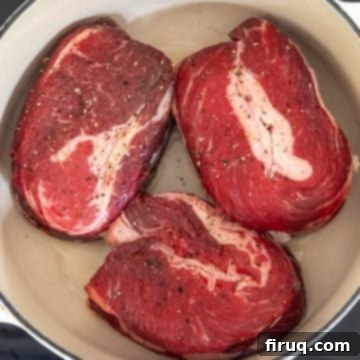
Step 1: Achieving the Perfect Sear. Heat your sturdy Dutch oven to medium-high heat and add a generous drizzle of olive oil. The key to incredible flavor is a proper sear. Place all of the seasoned short ribs into the hot Dutch oven at the same time, if possible, arranging them tightly packed. This helps to minimize the escape of steam, which can prevent browning and essentially “steam” the meat rather than searing it. Searing creates the Maillard reaction, a chemical process that gives food a desirable browned crust and complex, savory flavors.
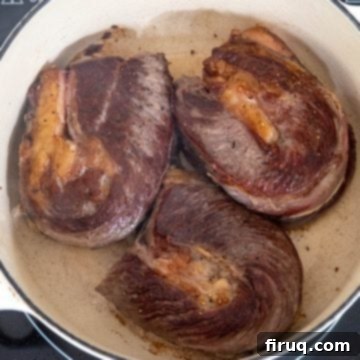
Step 2: Building Flavor with a Golden Crust. Sear the short ribs on all sides, ensuring each piece develops a beautiful, golden brown crust. This should take approximately 3-5 minutes per side. Resist the urge to move them too soon; let that crust form! Once adequately seared, carefully remove the short ribs from the Dutch oven and set them aside on a plate. This browning contributes immensely to the final depth of flavor in your ragu. At this point, preheat your oven to 325℉, preparing for the slow braising process.
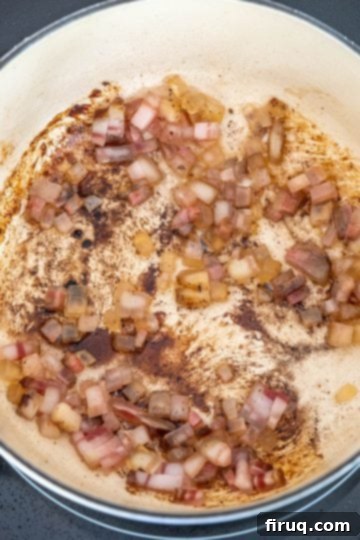
Step 3: Rendering the Pancetta. Reduce the heat on your Dutch oven to medium. Add the chopped pancetta and allow it to fry gently until golden brown and crispy, which usually takes about 5-7 minutes. For pancetta, you really want to go low and slow; rendering the fat gradually extracts maximum flavor and yields perfectly crisp bits. Depending on your burner’s heat, you might even need to bring the temperature down to medium-low. This rendered fat will be the flavorful base for your soffritto.
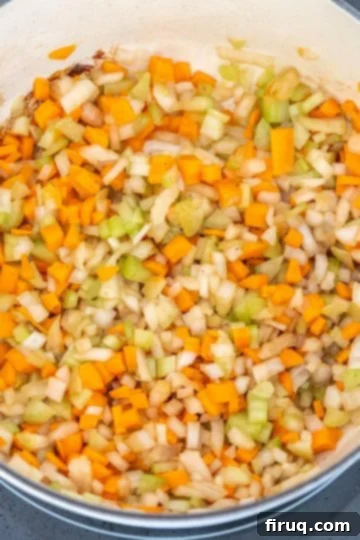
Step 4: Building the Soffritto. Once the pancetta has rendered and has a lovely crust, remove it with a slotted spoon and set it aside with the short ribs. Carefully remove some of the rendered oil, leaving approximately 2 tablespoons in the pot. Now, add your chopped carrots, onions, and celery – the classic soffritto. Sauté these aromatics for 5-8 minutes, or until they begin to soften and become translucent. Then, stir in the minced garlic and sauté for just 1-2 more minutes until fragrant. Be careful not to burn the garlic, as this can make it bitter.
Step 5: Caramelizing Tomato Paste. Add the tomato paste to the sautéed vegetables and stir to combine thoroughly. Continue to sauté for another 3 minutes. During this time, the tomato paste will start to caramelize and become stickier, intensifying its flavor. Don’t worry if it creates some brown spots on the bottom of the pan – these are invaluable “fond” bits that will add incredible flavor when deglazed.
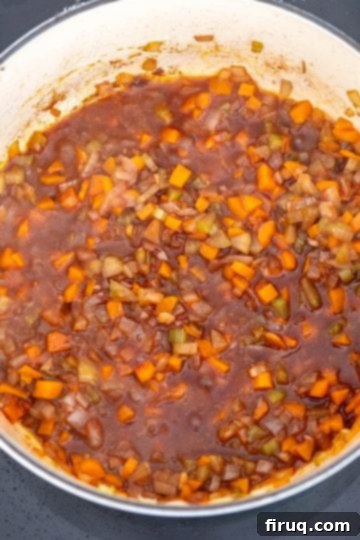
Step 6: Deglazing with Red Wine. Pour in the red wine, scraping the bottom of the Dutch oven with a wooden spoon to release all those flavorful brown bits (the “fond”) created by the searing and sautéing. Return the crispy pancetta to the pan at this stage. Bring the wine to a vigorous simmer and let it reduce for about 5 minutes. The wine should be reduced by approximately half and should feel noticeably thickened. This reduction process concentrates the wine’s flavor and burns off the alcohol, leaving behind a rich essence that deeply flavors the ragu.
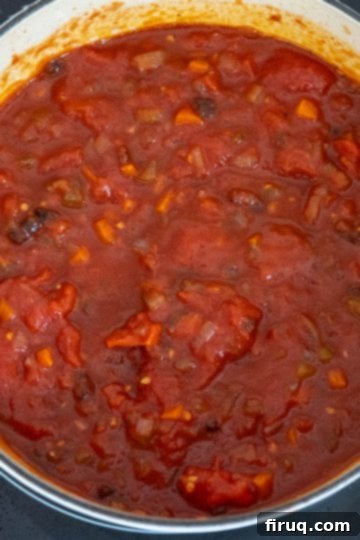
Step 7: Adding Tomatoes and Basil. Once the wine has reduced, it’s time for the star of the sauce: the whole plum tomatoes. Add them to the pot, either crushing them by hand for a rustic texture or pulsing them briefly in a food processor if you prefer a smoother sauce. (I personally prefer the hand-crushed method; the tomatoes will naturally break down further in the sauce over the extended cooking time.) Bring the tomato mixture to a gentle simmer. Finally, stir in the fresh basil, allowing its aromatic oils to infuse the sauce.
Step 8: The Braising Begins. Carefully nestle the seared short ribs into the simmering sauce. It’s crucial that they are buried about halfway, not fully submerged. This technique ensures they braise (cook in moist heat) rather than simply boil, allowing the top portion to brown and develop richer flavor while the bottom absorbs the luscious sauce. Cover the pot tightly with its lid and transfer it to the preheated 325℉ oven. Let it braise undisturbed for the initial 1.5 hours.
Step 9: Checking for Tenderness. After the initial 1.5 hours, remove the cover from the Dutch oven. Continue to braise uncovered, checking the short ribs for tenderness every 15 minutes. The goal is “fork tender” – meaning the meat should yield easily to a fork with very little resistance. Once this point is reached, carefully remove the pot from the oven. Don’t be concerned if the sauce appears slightly thin at this stage, as shown below; it will continue to thicken as it rests and once the shredded meat is incorporated.
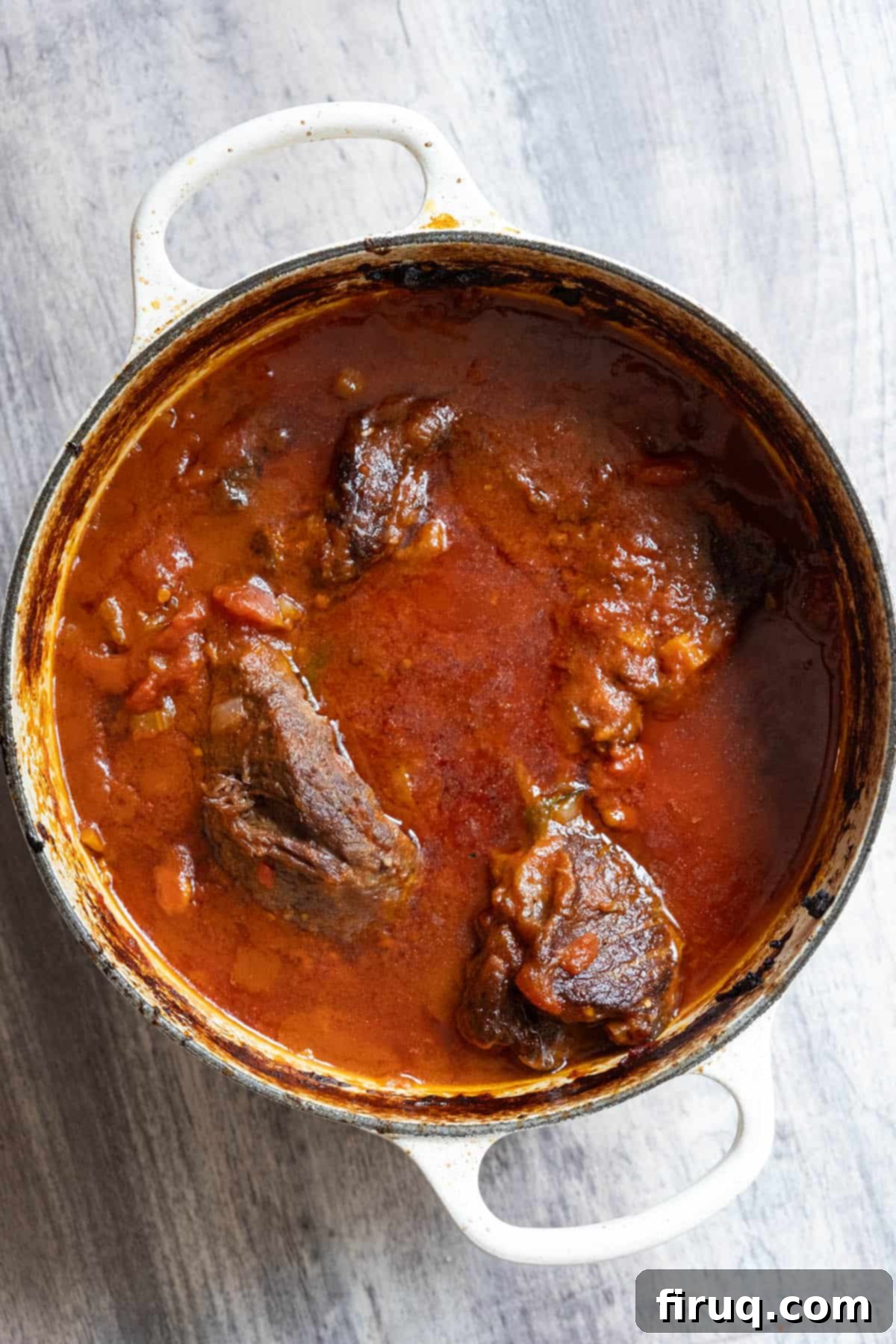
Step 10: Shredding the Tender Meat. Carefully remove the braised short ribs from the pot and transfer them to a bowl. Using two forks, gently shred the meat into rustic pieces. This is where you’ll truly appreciate the tenderness achieved through braising. When shredding, the meat shouldn’t fall apart without any effort, but it also shouldn’t feel like a struggle. There should be some mild effort in shredding, but it should detach easily, indicating perfect doneness.
Step 11: Finishing the Ragu. Once the meat is completely shredded, return it to the pot, mixing it thoroughly with the rich, aromatic sauce. This allows the shredded short ribs to soak up all those incredible flavors, making the ragu even more cohesive and delicious. The sauce will naturally thicken further as the meat is incorporated and as it rests.
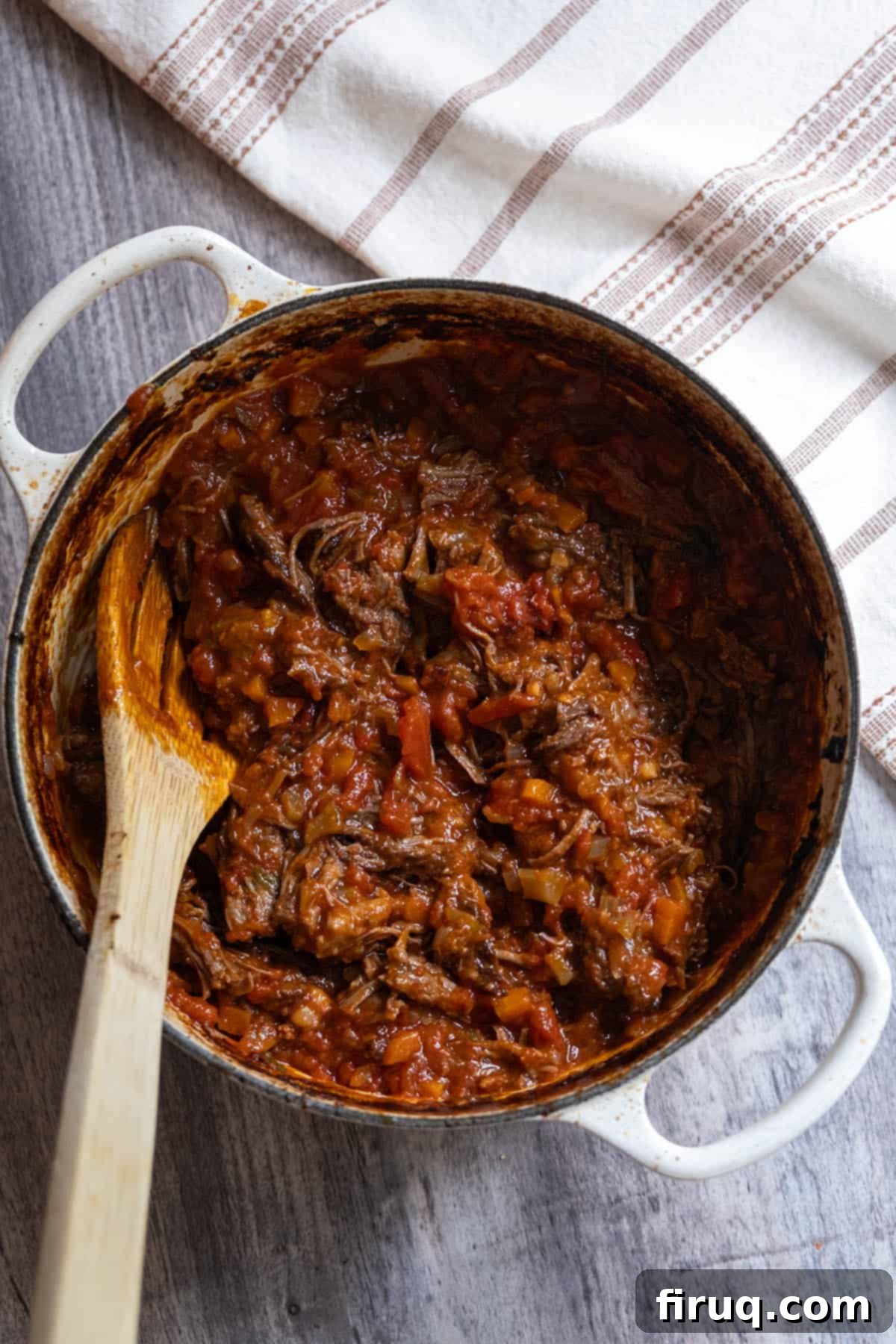
Pro-Tips for a Perfect Short Rib Ragu
Achieving restaurant-quality short rib ragu at home is within reach with these expert tips:
- The Art of Braising: Half-Submerged is Key. This might sound counter-intuitive, but for truly exceptional braised short ribs, only place the meat halfway into the sauce. If the short ribs are fully submerged, they will essentially boil, resulting in a less flavorful, mushier texture. Braising allows the exposed part of the meat to develop a slightly caramelized, richer exterior, while the submerged portion slowly absorbs the liquid and becomes incredibly tender. You want them to have some room to breathe and benefit from both moist and dry heat. If your short ribs are completely under the sauce, consider using a larger Dutch oven or removing a small amount of liquid. This balance is crucial for deep flavor and a melt-in-your-mouth texture.
- Mastering the Sear: Don’t Rush the Crust. Searing is not just about color; it’s about building foundational flavor through the Maillard reaction. It’s incredibly important to sear correctly. Don’t move the short ribs until you’re absolutely sure they have developed a really good, deep golden-brown crust. Patience is key here; prematurely moving the meat prevents proper browning and can lead to steaming. Once a robust crust has formed, it will naturally “peel” away from the pan when you go to flip it. It’s also highly beneficial to have the short ribs all in the pot at one time for searing, if your Dutch oven allows. This helps maintain high heat and decreases the escape of steam, which, as mentioned, can toughen the meat and hinder that coveted crust.
- Rest Your Meat: After braising and before shredding, allow the short ribs to rest for 10-15 minutes. This allows the juices to redistribute, leading to more tender and flavorful meat.
The Perfect Pairing: Serving Your Ragu with Gnocchi
While this rich short rib ragu is versatile, serving it with pillowy potato gnocchi creates an undeniably exquisite experience. The soft, tender gnocchi are perfect for soaking up every last drop of the luxurious sauce.
To prepare your gnocchi, bring a large pot of salted water to a rolling boil. Add your gnocchi (store-bought or homemade) and cook according to package directions. Gnocchi typically cooks very quickly, often floating to the surface when done.
The secret to serving truly remarkable gnocchi with ragu is to finish them together. Once the gnocchi are cooked, drain them and immediately add some of the rich short rib ragu to a separate pan set over medium heat. Add the cooked gnocchi to the pan with the sauce. Bring the sauce and gnocchi to a gentle simmer and combine them well. This essential step allows the delicate gnocchi to absorb some of the sauce and its incredible flavors, creating a harmonious and cohesive dish. It’s a must for maximizing flavor and texture!
Plate your gnocchi and ragu generously, perhaps with a sprinkle of freshly grated Parmesan cheese and a few leaves of fresh basil for an aromatic garnish. The tender short ribs, rich sauce, and fluffy gnocchi create a symphony of textures and tastes.
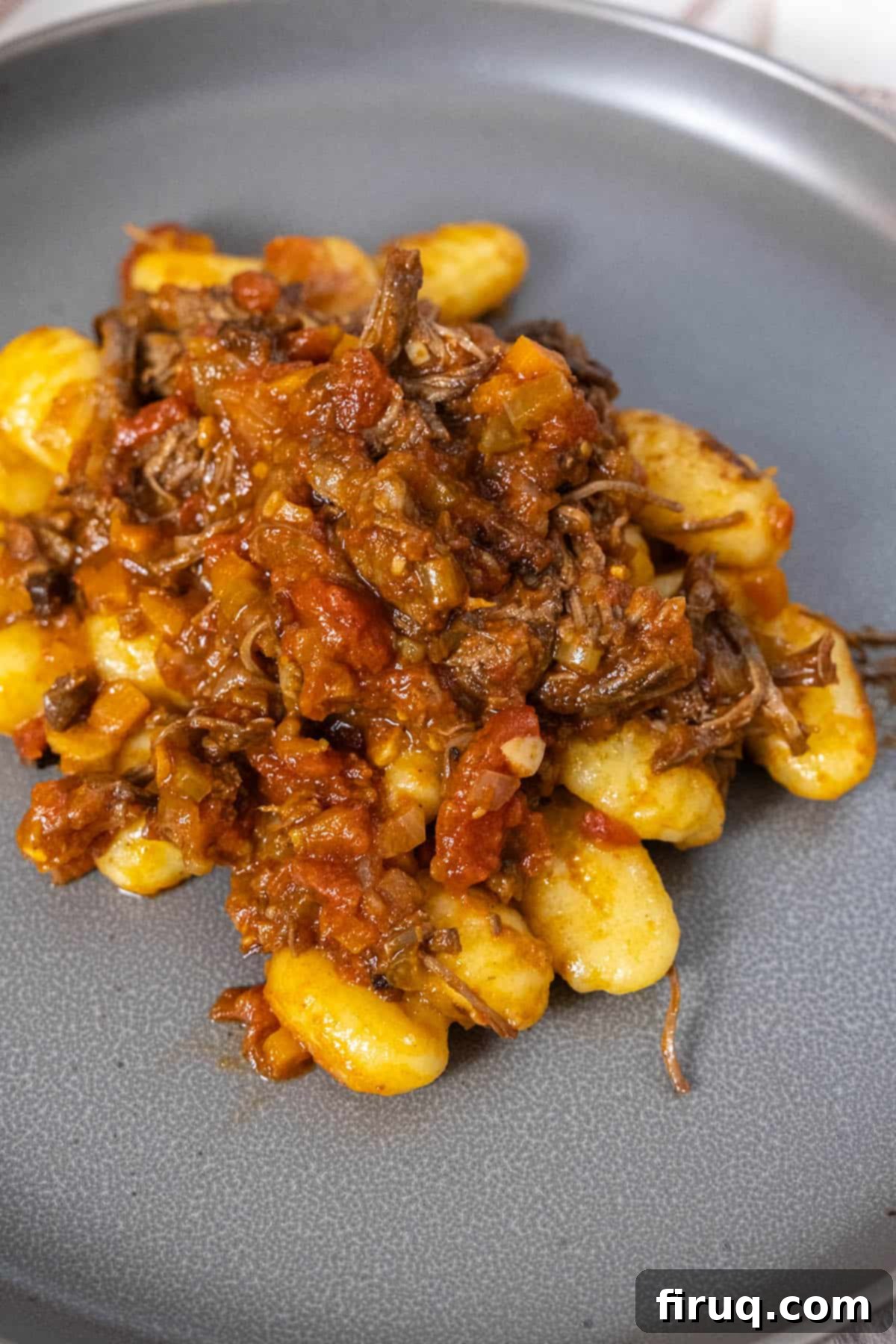
Recipe Frequently Asked Questions
While our recipe features gnocchi, the beauty of a rich short rib ragu is its versatility. You certainly don’t have to limit yourself to gnocchi! Excellent alternatives include hearty pastas like rigatoni or pappardelle, which are perfect for capturing the thick sauce. For a different texture, consider serving it over creamy polenta, which offers a smooth, comforting contrast, or classic fluffy mashed potatoes, creating a hearty, satisfying meal. Don’t forget a side of crusty Italian bread to soak up every last bit of that delicious sauce!
Yes, in a way, they do. Short ribs are naturally quite tough to begin with due to their high content of connective tissue. This tissue needs an extended period of low, moist heat to break down effectively. During the initial stages of braising, the meat will remain firm. However, there isn’t an intermediate stage where they become *even tougher* before tenderizing. They simply go directly from their initial tough state to becoming incredibly tender and succulent. Braising is the optimal cooking method because it provides the sustained heat and moisture necessary to dissolve the collagen in the connective tissue into gelatin, resulting in that desirable fall-apart tenderness. This long, slow process ensures the meat reaches its ultimate melt-in-your-mouth texture.
Absolutely! In fact, many Italian sauces, including ragu, often taste even better the next day as the flavors have more time to meld and deepen. This makes it an ideal dish for entertaining or meal prepping. Follow the storage instructions provided below for the best results.
Yes, this ragu freezes beautifully! It’s a fantastic recipe to double batch and freeze for future quick and delicious meals. Refer to the ‘Storing and Reheating’ section for detailed freezing instructions.
More Delicious Pairings for Your Italian Short Ribs
To complement the richness of Italian short rib ragu, consider pairing it with fresh, vibrant side dishes and a delightful dessert to round out your meal:
- Flavorful Vegetables: Lighten the meal with some delicious greens like Sauteed Rapini with Garlic, offering a pleasant bitterness that cuts through the richness of the ragu. A crisp Traditional Caesar Salad provides a refreshing, tangy contrast. Or, for another authentic Italian green, try our Italian Lacinato Kale Recipe, gently sautéed to perfection.
- Irresistible Dessert: No Italian dinner is complete without a sweet ending. Indulge in a celebratory Rainbow Cookie Cake, a colorful and almond-flavored treat, or enjoy the comforting chewiness of our Chewy White Chocolate Macadamia Nut Cookies.
Storing and Reheating Your Ragu for Future Enjoyment
This generous recipe yields approximately 10 servings total, depending on the type of pasta or accompaniment you choose, so you’ll likely have delicious leftovers to enjoy! Proper storage ensures your ragu stays fresh and flavorful.
Storing Cooked Gnocchi and Ragu: If you’ve already combined the gnocchi with the ragu, store any leftovers in an airtight container in the refrigerator for up to 3 days. The gnocchi might soften slightly over time, but the flavors will still be fantastic.
Storing Ragu Separately for Extended Freshness: The ragu itself can be stored in the refrigerator for 3-4 days. However, to extend its freshness significantly up to 6-7 days, follow this rapid cooling method: Once the sauce is finished cooking and you have removed the portion you intend to serve, transfer the remaining hot ragu to a new, clean pot. Immediately place this pot into a sink filled with ice water (ensuring the water level doesn’t reach the top of the pot). Stir the sauce periodically until it feels thoroughly cold to the touch. This rapid cooling technique quickly brings the temperature of the sauce down, which dramatically inhibits the quick growth of bacteria. Once chilled, transfer the ragu to an airtight container and store it in the refrigerator.
Freezing for Long-Term Storage: For longer storage, the ragu will keep beautifully in the freezer for up to 3 months. Portion it into freezer-safe bags or containers, leaving a little headspace for expansion. Thaw overnight in the refrigerator before reheating.
Reheating Instructions: To reheat, simply place the desired amount of ragu in a saucepan over medium-low heat. Bring it to a low simmer, stirring occasionally, until thoroughly heated through. You can then serve it over freshly cooked pasta or gnocchi, or, as recommended, add your cooked pasta or gnocchi directly to the pan with the simmering sauce to allow it to soak up some of that rich flavor.
Watch How It’s Made: Video Instructions
Explore More of Our Favorite Italian Dinners
If you loved this Italian Short Rib Ragu, be sure to check out some of our other beloved Italian recipes for your next family meal:
- Restaurant-Style Chicken Scarpariello
- Italian Stuffed Peppers in Tomato Sauce
- Restaurant-Style Chicken Saltimbocca
- The BEST Chicken Pizzaiola
We pour our heart into creating these recipes for you. Please leave a comment and a star rating below in the recipe card if you try this fantastic short rib ragu! We absolutely love to hear what you think of our recipes and how they turn out in your kitchen. Don’t hesitate to tag us on Instagram @vindelgiudice to share your culinary creations!
📖 Recipe
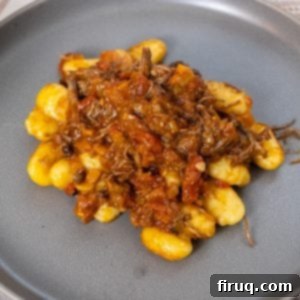
Italian Short Ribs with Gnocchi
Vincent DelGiudice
Pin Recipe
Equipment
-
1 5-6 qt dutch oven
Ingredients
- 1.5 lbs boneless short ribs
- 2 carrots, chopped
- 2 celery ribs, chopped
- 1 medium onion, chopped
- 2 cloves garlic, minced
- 28 oz can whole plum tomatoes
- ¾ cup red wine
- 2 tablespoon tomato paste
- ¼ cup chopped pancetta
- 1 teaspoon kosher salt
- 1 handful basil
- crushed black pepper
- 1 lb gnocchi
Instructions
-
Take the short rib out of the refrigerator 30 minutes ahead of time. Season both sides with salt and pepper. Heat the dutch oven to medium-high heat and add olive oil. Sear the short ribs on both sides for 3-5 minutes until they have a golden brown crust. Set them aside. Preheat the oven to 325℉.
-
Lower the heat to medium. Add the pancetta and saute until golden brown, about 5-7 minutes. Remove and set them aside. Remove some of the oil remaining. Leave about 2 tablespoon of oil.
-
Add the carrots, onions, and celery. Saute for 5-8 minutes or until they begin to soften. Stir in the garlic and saute for 1-2 more minutes. Then add tomato paste and combine. Saute for another 3 minutes. Add the red wine and return the pancetta to the pan. Simmer for 5 minutes.
-
Once the wine is reduced by about half, add in the whole plum tomatoes, crushing them by hand, or pulsing them in a food processor. Bring the tomatoes to a simmer. Add the basil. Then place the short ribs in the sauce, buried about halfway. Cover the pot, and place in the oven for 1.5 hours. Remove the cover after 45 minutes. Check the short rib every 15 minutes after you remove the cover for tenderness. Once the short rib is fork tender remove the pot from the oven.
-
Bring a pot of water to a boil. Add your gnocchi and cook as directed.
-
Remove the short ribs and place them into a bowl. Use two forks to shred the meat. Once completely shredded, return to the pot and mix with the sauce. Add some sauce and the gnocchi to a pan on medium heat. Bring the sauce to a simmer, combine with the gnocchi, and serve with extra sauce on top!
Notes
- Don’t move the short ribs while searing. Let them sit there until the crust develops. The more you move them, the more steam you will create which will toughen the meat.
- Don’t completely submerge the meat in the sauce. If you don’t use a big enough pot the meat will be completely submerged and not braise. You want the meat to only be halfway into the sauce.
